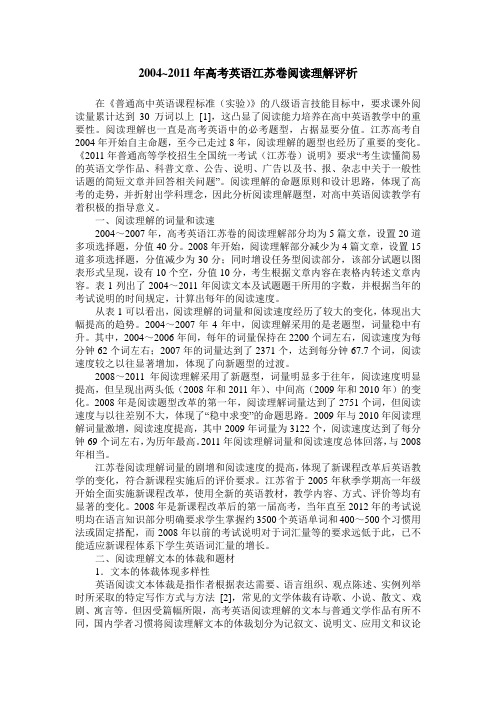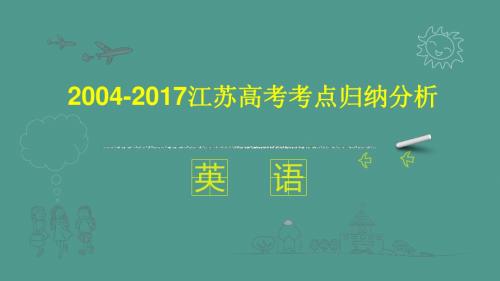近年江苏英语高考回顾分析
- 格式:ppt
- 大小:2.47 MB
- 文档页数:114

近三年英语高考江苏卷单项选择试题分析及解题指导摘要:作为高考的一个重要题型,单项选择主要用来考查考生英语基础知识和基本语法掌握的情况,考查学生应用英语的能力。
近几年来,随着课改的深入,该题型在考查内容上正在发生微妙的变化。
本文对近三年英语高考江苏卷单项选择题进行对比分析,总结出该题型的命题特点,探讨有效的解题方法,希望给来年复习备考一点启示。
关键词:高考;单项选择;特点;解题方法;启示作者简介:王永强,任教于江苏省丹阳高级中学。
单项选择以其“覆盖面广、重点突出”的特点,备受各级各类考试的青睐,并被广泛的采用。
就目前我国英语教学的实际情况来看,大量的时间被用来讲授字词汇和语法知识,学生平时操练最多的也是单项选择题。
因此,分析该题型考查内容和命题特点,研究近年来该题型的命题趋势,探讨解题方法和技巧,对于教师的教学和考生的备考,具有一定的意义。
本文试图对近三年英语高考江苏卷单项选择题进行对比分析,总结出该题型的命题特点,探讨有效的解题方法,进而期望给来年的复习备考一点启示。
一、命题特点以下是2006-2008年江苏卷单项选择考查内容的分布情况:2006-2008年江苏卷单项选择考查内容及题量(略)。
从表中可以看出,近三年高考英语江苏卷具有以下几个特点:1.注重考查基础知识,考点分布相对稳定集中。
语言基础知识教学历来都是语言教学的重点,也是考查的重点。
近三年的单项选择题每年的考点相对稳定,在所列的全部13项中,每年都考查了其中的10项,动词的时态与语态、情态动词、非谓语动词、形容词和副词、定语从句及交际用语每年必考。
考查的重点集中在动词。
由上表可以看出,对动词的时态与语态、情态动词、非谓语动词的考查,2006年和2008年(包括2个固定搭配)为6个,占该大题的三分之一强,2007年(包括2个固定搭配)为8个,超过了一半,因此在日常教学中,应对动词给予充分的重视。
2.注重创设语言环境,题干更加贴近生活。
单项选择题已经由传统的单纯考查语法知识逐渐向英语应用的方向发展。

江苏高考英语试卷分析江苏高考英语试卷分析第Ⅰ卷(选择题,共100分)注意事项:1.答第Ⅰ卷前,考生务必将自己的姓名、准考证号、考试科目涂写在答题卡上。
2.1—65小题选出答案后,用2B铅笔把答题卡上对应题目的答案标号涂黑,如需改动,用橡皮擦干净后,再选涂其他答案标号,在试题卷上作答无效。
第一部分英语知识运用(共两节,满分50分)第一节语法和词汇知识(共20小题;每小题1分,满分20分)从A、B、C、D四个选项中,选出可以填入空白处的最佳选项,并在答题卡该项涂黑。
1. —Heres your change.——A. Thank you.B. Dont mention it.C. No problemD. With pleasure.2. In most countries, a university degree can give you flying start in life.A. the; aB. the; 不填C.不填; 不填D.不填; a3. — I take the book out?—Im afraid not.A. WillB. MayC. MustD. Need4. A great number of students said they were forced to practise the piano.A. to questionB. to be questionedC. questionedD. questioning5. Tired, Jim was fast asleep with his back a big tree.A. inB. belowC. besideD. against6. Some people eat with their eyes. They prefer to order what nice.A. looksB. smellsC. feelsD. tastes7. On my desk is a photo that my father took of when I was a baby.A. himB. hisC. meD. mine8.Jenny was looking for a seat when,luckily,a man and left.A.took upB.got upC.shut upD.set up9.We laugh at jokes,but seldom about how they work.A.we thinkB.think weC.we do thinkD.do we think10.After graduating from college,I took some time off to go travelling, turned out to be a wise decision.A.thatB.whichC.whenD.where11.In many peoples opinion,that company,though relatively small,is pleasant .A.to deal withB.dealing withC.to be dealt withD.dealt with12.The school was moved out of downtown as the number of students had grown too .A.smallB.fewC.1argeD.many13.一Im sorry.That wasnt of much help.一Oh, .As a matter of fact,it was most helpful.A.sure it wasB.it doesnt matterC.of course notD.thanks anyway14.How much one enjoys himself travelling depends largely on he goes with,whether his friends or relatives.A.whatB.whoC.howD.why15.Such poets as Shakespeare widely read,of whose works,however,some difficult to understand.A.are;areB.is;isC.are;isD.is:are16.一When shall we restart our business?一Not until we our plan.A.will finishB.are finishingC.are to finishD.have finished17.The lawyer listened with full attention, to miss any point.A.not tryingB.trying notC.to try notD.not to try18.Youve failed to do what you to and Im afraid the teacher will blame you.A.will expectB.will be expectedC.expectedD.were expected19.If you have a job, yourself to it and finally youll succeed.A.do devoteB.dont devoteC.devotingD.not devoting20.Because of the heavy traffic,it was already time for lunch break she got to her office.A.sinceB.thatC.whenD.until第二节完形填空(共20小题;每小题l 5分,满分30分)阅读下面短文,从短文后各题所给的四个选项(A、B、C和D)中,选出可以填入空白处的最佳选项,并在答题卡该项涂黑。

2004~2011年高考英语江苏卷阅读理解评析在《普通高中英语课程标准(实验)》的八级语言技能目标中,要求课外阅读量累计达到30万词以上[1],这凸显了阅读能力培养在高中英语教学中的重要性。
阅读理解也一直是高考英语中的必考题型,占据显要分值。
江苏高考自2004年开始自主命题,至今已走过8年,阅读理解的题型也经历了重要的变化。
《2011年普通高等学校招生全国统一考试(江苏卷)说明》要求“考生读懂简易的英语文学作品、科普文章、公告、说明、广告以及书、报、杂志中关于一般性话题的简短文章并回答相关问题”。
阅读理解的命题原则和设计思路,体现了高考的走势,并折射出学科理念,因此分析阅读理解题型,对高中英语阅读教学有着积极的指导意义。
一、阅读理解的词量和读速2004~2007年,高考英语江苏卷的阅读理解部分均为5篇文章,设置20道多项选择题,分值40分。
2008年开始,阅读理解部分减少为4篇文章,设置15道多项选择题,分值减少为30分;同时增设任务型阅读部分,该部分试题以图表形式呈现,设有10个空,分值10分,考生根据文章内容在表格内转述文章内容。
表1列出了2004~2011年阅读文本及试题题干所用的字数,并根据当年的考试说明的时间规定,计算出每年的阅读速度。
从表1可以看出,阅读理解的词量和阅读速度经历了较大的变化,体现出大幅提高的趋势。
2004~2007年4年中,阅读理解采用的是老题型,词量稳中有升。
其中,2004~2006年间,每年的词量保持在2200个词左右,阅读速度为每分钟62个词左右;2007年的词量达到了2371个,达到每分钟67.7个词,阅读速度较之以往显著增加,体现了向新题型的过渡。
2008~2011年阅读理解采用了新题型,词量明显多于往年,阅读速度明显提高,但呈现出两头低(2008年和2011年)、中间高(2009年和2010年)的变化。
2008年是阅读题型改革的第一年,阅读理解词量达到了2751个词,但阅读速度与以往差别不大,体现了“稳中求变”的命题思路。


高考英语试卷近五年真题
近年来,高考英语试卷一直备受广大考生关注。
通过对近五年高考英语试卷的分析,我们可以发现一些共性和变化。
接下来,让我们来回顾一下近五年高考英语试卷的一些重要题型和趋势。
一、阅读理解
阅读理解一直是高考英语试卷的重头戏,占据了相当大的篇幅。
近五年来,阅读理解题的题材越来越多样化,涉及到社会、文化、科技等方方面面的话题。
同时,题目难度也有所增加,考查考生的综合理解能力。
二、完形填空
完形填空题在高考英语试卷中也占据一定的比重。
近五年来,完形填空题目更加贴近生活,考查考生对英语语法、词汇和逻辑推理能力的掌握。
三、语法填空
语法填空题目在近五年的高考英语试卷中逐渐增多。
这类题目考察考生对英语语法规则的掌握程度,对于细节的把握要求很高。
四、短文改错
短文改错是考察考生对于语法和表达规范的理解程度。
近五年来,短文改错题目中常涉及到一些易混淆的词汇用法和句子结构。
五、写作
写作部分一直是考生的难点。
在近五年的高考英语试卷中,写作题目更强调对于时事热点和议论文写作技巧的应用。
综上所述,通过对近五年高考英语试卷的分析,我们可以看出试卷题型和难度在不断变化之中。
考生在备战高考英语的过程中,需要不断提高自己的英语综合能力,增强对各种题型的应对能力。
只有通过不断的练习和积累,才能在高考中取得优异的成绩。
愿所有的考生都能在高考中取得理想的成绩,实现自己的梦想!。

2012年高考已结束,写些文字总结一下。
继承中求稳定创新中谋发展背景简介:1949年中华人民共和国成立。
1950年全国高考统考,英语其中一门。
1978年恢复高考第一年,英语其中一门。
2004年江苏自主命题元年。
2012年,江苏高考自主命题走过了不平凡的9年,一直在稳定和发展中,不断探索,不断前进。
下面来简单谈谈这两个方面。
(一)、继承中求稳定1、从题数总量看,保持稳定,维持在6大项上。
2、从单项上看:听力保持稳定,一直是用的全国卷。
题数20个,分值20分。
单项选择保持稳定,一直是15个,分值15分。
完形填空保持稳定,一直是15个,分值2004-2007年,30分;2008-2012年,20分。
阅读理解保持稳定,2004-2007年,40分;2008-2012年,30分。
写作第一项基本保持稳定,2004-2005年,改错;2006-2007年,对话填空;2008-2012年,任务型填空,都是10分。
写作第二项保持稳定,一直是一篇小作文,25分。
3、从命题依据上看,基本就是课程标准和考试说明。
4、从能力要求上看,基本就是考查学生的基本的听说读写译,良好的审题能力,解题能力和书写能力,较好的心里能力等。
5、从难度系数上看,全省保持在平均分72分左右。
(二)、创新中谋发展这个主要体现在各个单项的细节上。
1、听力题一直都是2节,第一节5段短对话,一遍,考查基本的wh-型问题和how-型问题。
第二节5段对话,二遍,前四篇男女对话,后一篇独白,基本也是细节辨认、归纳,判断推理和主旨大意的概括能力。
但2012年的第10段材料,却改成了对话式,话题转到了教育上,更贴近学生,更贴近学教教育。
这要求我们,平时注重基础知识的学习和对学生的道德情感的教育和指导。
2、单选题基本是15道,考查词法,如名词辨析,代词辨析等;句法,如3大从句的定语从句和状语从句,及名词性从句都是必考内容;基本的语法,如倒装,强调,附加疑问句,虚拟语气等;还有一些难点,如非谓语、时态语态、情态动词等。
2022年江苏高考英语试卷解析篇1Title: Analysis of the 2022 Jiangsu College Entrance Examination English PaperIntroductionThe 2022 Jiangsu College Entrance Examination English paper was recently conducted, and as always, it attracted attention from students, teachers, and parents alike. In this document, we will provide an in-depth analysis of the exam, discussing the difficulty level, question types, and overall performance of students.Section I: ListeningThe listening section of the exam consisted of three parts, each with multiple-choice questions. The first part included short conversations, with questions focusing on details, such as the location and purpose of the conversation. The second part featured longer conversations and discussions, requiring a deeper understanding of context and speaker intentions. The third part involved listening to a talk or lecture, with questionstesting students' ability to comprehend main ideas and key details.Overall, students found the listening section to be challenging, with some expressing difficulty in catching all the information due to the fast pace of the recordings. However, with adequate practice and preparation, most students were able to complete this section successfully.Section II: ReadingThe reading section of the exam was divided into four parts, including multiple-choice, matching, and fill-in-the-blank questions. The passages covered a range of topics, from technology and environmental issues to personal experiences and social trends.Students found the reading section to be relatively easier compared to the listening section, as the questions were straightforward and required a good understanding of vocabulary and grammar rules. However, some students struggled with time management, particularly in the longer passages, and had to rush through the questions towards the end.Section III: WritingThe writing section of the exam consisted of two parts, an essay and a letter-writing task. The essay prompt asked students to discuss the advantages and disadvantages of social media, while the letter-writing task required students to write a letter to a friend inviting them to visit your city.Students generally found the writing section to be manageable, with the essay prompt allowing for a variety of perspectives and arguments. However, some students struggled with organizing their ideas coherently and effectively, leading to less developed arguments and weaker supporting details.ConclusionOverall, the 2022 Jiangsu College Entrance Examination English paper was considered to be a fair and balanced assessment of students' English language skills. While some sections were more challenging than others, with adequate preparation, most students were able to demonstrate their proficiency in listening, reading, and writing.As educators, we encourage students to continue practicing and improving their English skills, as proficiency in this important language will undoubtedly open up opportunities and pave the way for future success. We wish all students the best of luck in their academic endeavors and hope that this analysis hasprovided valuable insights into the 2022 Jiangsu College Entrance Examination English paper.篇2Title: Analysis of the 2022 Jiangsu College Entrance Examination English PaperIntroduction:The 2022 Jiangsu College Entrance Examination English paper was recently released and is being widely discussed by students, teachers, and parents. In this article, we will analyze the different sections of the paper, the difficulty level of the questions, and provide some tips for future test-takers.Reading Comprehension:The reading comprehension section of the paper consisted of four passages, each followed by a series of multiple-choice questions. The passages covered a range of topics, from environmental issues to technology and society. The questions were designed to test students' ability to understand main ideas, infer meanings, and identify specific details. Overall, the reading comprehension section was considered moderate in difficulty, with some questions requiring careful reading and analysis.Writing:The writing section of the paper required students to write an essay on a given topic. The topics ranged from personal experiences to social issues, challenging students to express their thoughts clearly and logically. Many students found the writing task to be manageable, with some opting to write a narrative essay while others chose to write a persuasive piece. The key to success in the writing section was to organize ideas effectively, use appropriate language and vocabulary, and maintain a coherent structure.Listening:The listening section of the paper consisted of a series of audio recordings, each followed by a set of questions. The recordings covered a variety of topics, including conversations, lectures, and interviews. Students were required to listen carefully and answer the questions based on the information presented in the recordings. The listening section was considered challenging by some students, as they had to focus on auditory comprehension and recall details from the recordings.Tips for Future Test-Takers:For future test-takers of the Jiangsu College Entrance Examination English paper, it is important to practice regularly in all four areas of language skills: reading, writing, listening, and speaking. Reading English materials such as books, articles, and newspapers can help improve vocabulary and comprehension. Writing practice essays on different topics can enhance writing skills and critical thinking. Listening to English podcasts, songs, and videos can help improve listening skills and pronunciation. Lastly, speaking English with classmates, teachers, or language partners can help build confidence and fluency in spoken English.Conclusion:In conclusion, the 2022 Jiangsu College Entrance Examination English paper was a comprehensive test of s tudents’ English language proficiency. The paper covered a range of topics and required students to demonstrate their abilities in reading, writing, listening, and speaking. By analyzing the different sections of the paper and providing tips for futuretest-takers, students can prepare effectively and achieve success in the college entrance examination.篇3Analysis of 2022 Jiangsu College Entrance Examination English PaperThe 2022 Jiangsu College Entrance Examination English paper was widely regarded as challenging yet fair by both students and teachers. The test consisted of four parts: listening, reading, writing, and translation, each designed to assess different language skills and abilities.In the listening section, students were required to listen to a series of dialogues and monologues and answer questions based on the information provided. The topics covered a wide range of situations, such as shopping, traveling, and daily life. The questions were designed to test students' ability to comprehend spoken English and make inferences based on context. Overall, the listening section was considered to be manageable for most students, although some found certain questions to be particularly tricky.The reading section of the exam included a variety of texts, such as articles, essays, and short stories. Students were asked to answer questions that tested their reading comprehension, vocabulary, and analytical skills. The texts covered a diverse range of topics, including current events, literature, and culture.Some students found the reading section to be challenging due to the complexity of the texts and the nuanced questions asked.The writing section of the exam required students to write an essay on a given topic. Students were given a choice between two prompts, allowing them to select the one that best suited their strengths and interests. The essay topics werethought-provoking and required students to demonstrate their ability to analyze and articulate their ideas effectively. Many students found the writing section to be challenging but rewarding, as it allowed them to showcase their writing skills and creativity.The translation section of the exam tested students' ability to translate between Chinese and English accurately and efficiently. Students were required to translate both written passages and spoken dialogue, demonstrating their proficiency in both languages. The translation section was considered to be particularly challenging for some students, as it required a deep understanding of both languages and the ability to convey meaning accurately.Overall, the 2022 Jiangsu College Entrance Examination English paper was considered to be a comprehensive and rigorous assessment of students' English language skills. The testcovered a wide range of topics and required students to demonstrate their ability to listen, read, write, and translate effectively. While some students found certain sections to be more challenging than others, the exam was generally seen as a fair and accurate reflection of students' proficiency in English.。
从近五年江苏英语高考作文浅析英语书面表达常熟外国语学校张英摘要:近年来江苏省英语高考中,考生在书面表达部分得分率普遍较低,笔者分析比较了近五年高考作文,试从教师和学生两方面找出解决问题的方法。
关键词:近五年江苏英语高考书面表达、失分的原因、书面表达能力提高的技-、问题的提出书面表达能力是学生对英语语言知识进行综合实践运用的一种能力。
高考英语书而表达,1=1的在于测试考生的英语表达能力,看其是否能够运用洋过的英语基础知识和掌握的基本技能,进行思想交流。
它要求考生能在有限时I'可内,以文字形式写出符合英语表达方式的百字短文。
在新颁布的《新课程标准》中,对学生写作技能方面的要求是:通过对学生激活灵感、整理思路、规划文章结构……遣词造句等写作技能的培养,使他们表述事实、观点和情感。
书而表达是髙考英语试卷屮难度最人部分°作为主观题,写作对考生英语的语法、词汇都有着较高的要求。
近年來江苏卷的英语写作都是半开放式的作文,2009年的书面表达题也不例外。
据了解,今年英语第二卷难度较大,考生的得分率也较低,总共35分,考生平均只能拿十六七分。
其中任务型阅读项总共10分,平均得分只有三点儿。
而作文总分25分,平均得分只有十三四分.那么是什么原因导致了考生如此低的得分率?作为一名高屮英语教师乂该如何培养学生的写作技巧呢?笔者想从以下儿方面做个分析:二、近五年江苏英语高考作文的分析笔者搜集了近五年江苏英语高考的书面表达题,试从体裁、题材、提示形式、开放性及词数做个分析比较,以了解近儿年高考英语书而表达的发展势态。
年份体裁题材提示形式开放性词数2005 年倡议书建设和谐社会提纲半开放1002006 年议论文奥运志愿者dos anddon’ ts表格半开放1002007 年发言稿阳光体育运动提纲半开放1202008 年演讲稿Being a表格半开放150goodlistener2009 年议论文人们使用鼠表格半开放150标的利弊从该表屮我们不难看出,近儿年来书而表达多为应用文、议论文。
05、06、07江苏高考英语试卷分析及思考无锡市洛社高级中学刘娟萍一.20XX年江苏高考英语试卷分析20XX年是江苏省自主命题的第二年,该卷在题型、词汇范围、分值、侧重点等方面与上年高考保持一致,仍然由听力、单项选择、完形填空、阅读, 改错、作文等几部分组成,且难度基本持平。
1.听力仍然沿用了全国卷的听力试题,语速适中,题目内容的覆盖面较广。
试题的大部分为细节信息题,部分试题考查了学生对对话主旨要义说话者的观点意图等的理解情况。
总的来说难度适中,但也有个别题的选项具有一定的迷惑性,如第一部分的第一小题,就是一道计算题。
考生须用听到的数据,经过计算后,方可得出答案。
2.单选题和04年的试题相比,难度也基本相当。
但试题设置得更加灵活,题干和04年相比略有加长,语境题有所增加。
单选题最明显的一个变化就是除了考查冠词的第一题之外,另有三题一题设置了两空,这在以往的高考英语试题中是难得见到的。
从考查的内容上看,试题的覆盖面很广,15个小题考查了十几个语言项目:冠词、形容词、副词及其比较级、代词、情态动词、非谓语动词、近义词比较、连词、主从复合句、倒装句等等。
考生如果基础知识过硬,拿高分并不太难,因为题目不偏、不怪,也没有超纲;但若基础知识不牢固,在单选题上失分的肯定大有人在。
3.完形填空题和04年相比,内容更容易理解。
文章的上下文逻辑关系清晰,所设的空格位置也比较合适,各题的选项多为针对故事的发展,学生只要能看懂故事的情节和脉络,就可以比较轻松地答题。
所以,这一项上,好生和中等生的差距不会太明显。
4.阅读理解题以说明文为主。
A篇介绍了一个和英国著名作家简·澳斯丁相关的一个旅游中心,B篇是对一个书店的口头介绍,C篇介绍的是撒哈拉节日,D篇涉及的是植物如何进行自我保护,E篇介绍科技知识给人类带来的利与弊。
题目的设置有主题推断、细节理解、词义推断、作者写作意图推断等。
因为文章生词量不大,文章易于理解,所以考生在这项上遇到的障碍应该不会太大。